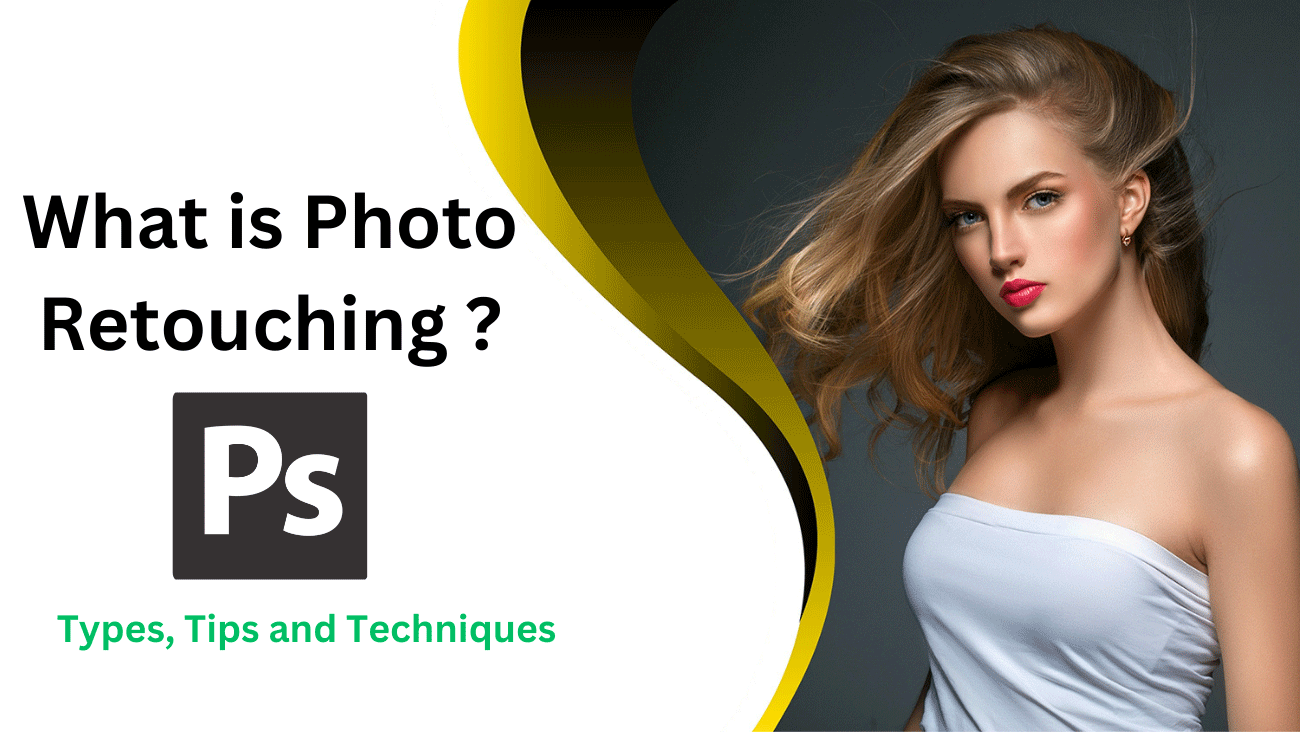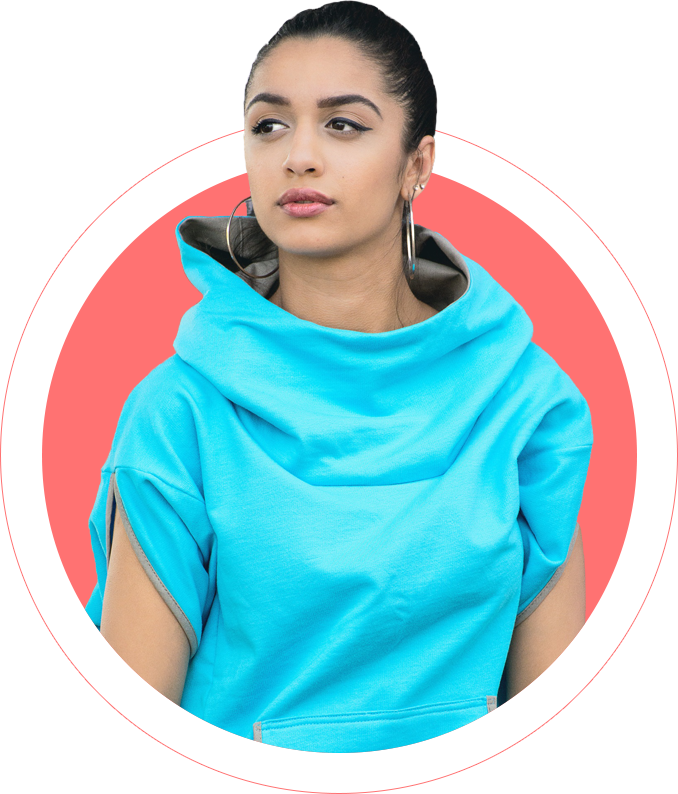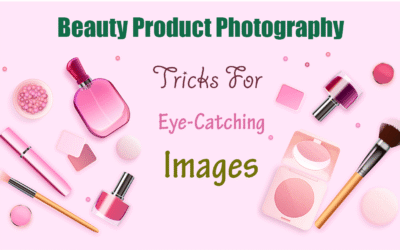Photo retouching involves detailed post-production work. However, it differs from simple editing. Retouching demands more effort and expertise. So, industries like fashion and advertising often hire skilled image retouchers for branding activities.
What is Photo Retouching?
Photo retouching is editing a photo to improve its quality. It removes flaws and enhances its look. Photo retouching is key in graphic design and commercial photography. It improves or changes how people and objects look. Essentially, it involves removing flaws and adjusting colors, tones, contrast, and brightness. This makes the final image stunning. The goal is to achieve a natural look while ensuring visual appeal. This is done using tools for skin smoothing, toning, eye brightening, and teeth whitening or straightening.
What is the Difference Between Basic Photo Editing and Photo Retouching?
The main difference between photo editing and retouching is the amount of work done on the image. Photo editing focuses on basic changes, while photo retouching involves more detailed adjustments.
- Basic Photo Editing: This is the essential work done after taking a photo. It includes simple tasks like cropping, adjusting brightness, and straightening. These steps help the image look better than the original shot.
- Photo Retouching: This is where the magic happens. Retouching involves more advanced changes that make a photo truly shine. The differences between a retouched photo and the original are clear, as the final result shows impressive improvements.
Both processes are important in creating beautiful images.
Different Types of Photo Retouching
Photo Retouching comes in many forms, and each type serves a different purpose. Let’s explore some of the most popular styles of image retouching together.
Fashion Retouching
Fashion brands often look for photo retouching services to enhance their images. This process involves adjusting and polishing photos, especially those featuring models, to make them even more eye-catching. When the final images shine, fashion lovers notice and feel inspired by the latest trends.
Model Photo Retouching
Models showcase the best in fashion. So, their images must be perfect. Model image retouching, or model retouching, boosts a model’s beauty and appeal. This work involves careful attention to detail, covering every part of the image to meet specific needs.
Beauty Retouching
Beauty retouching enhances hair, faces, and skin products. It’s vital for industries that make us look and feel good. Showing before-and-after images can inspire potential customers and boost sales.
Body Retouching
Body retouching enhances a person’s shape in a flattering way. It can slim areas, smooth skin, and highlight curves. We also adjust proportions to create a balanced look. Body retouching aims to celebrate each person’s beauty. It helps them feel confident and happy.
High-End Retouching
High-end retouching is a specialized skill that requires the expertise of professionals. These experts use photo retouching software, like Photoshop and Lightroom, to enhance images. Their meticulous work keeps every pixel intact. The result? Beautiful, stunning images.
Portrait Retouching
Portrait photography is a wonderful way to show off people’s unique personalities. In portrait retouching, a skilled retoucher gently improves the image. They smooth out flaws, adjust colors and brightness, and remove dark spots. This thoughtful process enhances the overall vibe of the photo, making it truly shine.
Headshot Retouching
This type of retouching work is really important. It helps create a fresh and flawless look, which is great for corporate use. A clean appearance can make a big difference. With a bit of thoughtful retouching, we can achieve a neat, clear, and professional look that everyone will appreciate.
Product Retouching
Product photo retouching helps make your products shine. It ensures that colors look great and the images are realistic, making them more appealing to buyers. When you sell products online, a well-done retouch can boost your chances of success and attract more customers.
Commercial Retouching
Commercial retouching boosts product images for ads and online sales. These platforms need appealing yet true-to-life images. It’s crucial to balance both, requiring careful attention to detail.
Skin Retouching
Photo Skin retouching improves photos by removing blemishes. Yet, it’s vital to keep some natural features. The general rule is that professional photo retouchers will smooth out temporary marks, while they often choose to keep birthmarks and moles. This way, your photos look polished but still true to you.
Hair Retouching
Do you have frizzy hair or loose strands in your photo? No worries. Hair retouching gives you a polished look. However, it requires patience and skill. While the changes might not always be obvious, the final results can really enhance your image.
Make-up Retouching
Camera shoots often call for models to wear make-up. However, sometimes the photos don’t fully show the details of the make-up. That’s where retouching becomes really helpful.
Make-up retouching enhances the beauty of the eyes, eyebrows, cheeks, lips, and jawline. It requires careful attention to detail for a natural, vibrant look.
Glamour Retouching:
Glamour retouching is also known as digital make-up. It involves advanced Photoshop techniques. This process focuses mainly on enhancing faces to highlight their charm and beauty.
Sometimes, simple editing isn’t enough to showcase the true beauty of a face. That’s when this magical tool comes into play.
Editorial Retouching
This type of retouching is meant for editorial images found in magazines and features. These images are not just for promotion; they help share ideas with viewers. The approach to editorial retouching can change based on the specific purpose of each image.
Creative Retouching
Creative photo retouching is a fun and artistic way to blend two or more subjects into one compelling image. This technique creates something unique that sparks curiosity and conversation. Because of the thought and effort involved, these projects often take more time than standard retouching.
Why is Photo Retouching Important?
Image retouching plays a vital role in showcasing professionalism. It helps clarify the subject of the image and removes distractions, making it easier to present your products effectively.
Here’s how retouching can enhance your photos:
Enhance the Images
Retouched images have a special charm that unedited photos often lack. When you choose to have your work retouched, you invite a deeper level of processing. This enhances the overall appeal of your images, making them visually stunning and enjoyable to look at.
Eliminate Imperfections
Not every image is perfect, but there are ways to fix that. With a few touch-ups, you can create images free from distractions and flaws. By removing these imperfections, you can capture the attention of potential customers and guide them to what really matters.
Show Your Brand’s Professionalism
Using polished images to showcase your products or services sends a clear message. It makes you stand out from competitors and shows you care about your work. This professionalism greatly impacts how people view your brand.
Engage More Viewers
Well-retouched images can attract more viewers. People are likely to stop and appreciate the details and effort behind a professionally edited photo. By getting your images done by experts, you can draw in your audience and keep them interested.
Different Photo Retouching Techniques
Here’s a friendlier and more constructive version of your text:
We’re excited to share some essential photo retouching techniques that can help enhance your images.
Brightness Adjustment
Brightness helps brighten or darken an image. It plays an important role in shaping how an image looks. By increasing brightness, you can lighten the image, while decreasing it will darken it.
Hue and Saturation
Hue means different colors, while saturation measures their intensity. Often, photos, especially in shoots, don’t reflect true colors. However, tweaking hue and saturation can enhance color variety in your images.
Curves Adjustment
Curves help adjust the tones in an RGB photo. You’ll see a diagonal line inside a square. Moving this line allows you to change the tones in specific areas, giving you control over shadows and highlights.
Frequency Separation
This technique separates image information into high and low frequencies, keeping them on different layers. The high frequency captures fine details, while the low frequency holds the tone and color information. This allows for easy adjustments without affecting other parts of the image.
Spot Healing
The spot-healing brush is designed to remove small marks or flaws from your images. It’s perfect for eliminating minor imperfections and achieving a flawless look.
Dodge and Burn
If an image is overexposed or underexposed, dodge and burn techniques help adjust the lighting. Dodging brightens areas, while burning darkens them. This way, you can manipulate exposure to get the best results.
Wrinkle Reduction
Instead of completely removing wrinkles, we focus on reducing them to maintain a natural look. Our retouching makes models appear youthful without looking unrealistic.
Blemish Removal
Blemishes like acne marks can distract from your image. We help remove temporary spots, ensuring your skin looks clean and natural.
Object Removal
Removing unwanted objects is a clever way to keep the focus on the subject of your image. This technique helps create a clearer and more engaging photo.
Photo Reshaping
Our Photo retouching services can reshape model images. Whether it’s enhancing muscle definition for men or slimming features for women, we can help achieve the desired look.
Eye Retouching
Eye retouching enhances the lighting in portraits. Done carefully, it adds depth and keeps the natural look while making the subject more engaging.
Eye Swap
If your subject isn’t looking at the camera, we can swap their eyes with a different photo to create a perfect shot without any distortion.
Braces Removal & Teeth Whitening
A great smile is inviting. We can remove braces (unless you want them) and whiten teeth, giving your images a bright and confident look.
Toning
Toning adjusts the warmth or coolness of colors in your image. This helps create the perfect mood and matches the overall feel you want to achieve.
Clone Stamp
The clone stamp tool lets you copy and blend parts of an image. This makes your edits look natural and unobtrusive.
Skin Smoothing
For portraits, skin appearance matters. Our skin smoothing technique helps even out bumps and imperfections, giving a rejuvenated look.
Digital Makeup
Digital makeup can enhance your features beautifully. With careful application, we can make your face appear more vibrant and glamorous.
Stray Hair Removal
Stray hairs can distract from the overall look. We tidy up any loose strands to ensure your model looks polished and professional.
Glare Removal
Glare can sometimes be distracting. We help reduce or remove glare to restore the natural beauty of your images.
Shadow Work
Adding or removing shadows can make your images look more realistic. Our expertise in shadow work helps ensure your photos appear professional.
Reflection Adjustment
Reflection is often sought in commercial photography. We can add or remove reflections to enhance the artistic quality of your images.
Head Swap
In group photos, if someone isn’t posing well, we can swap heads to create the perfect shot without anyone noticing.
Noise Reduction
Noise can harm image quality. Our techniques help reduce noise while keeping the main image intact, ensuring you get clear results.
Slimming Edits
Sometimes, images may distort and make objects appear larger. We adjust these features to ensure they look just right.
Liquify Effect
The liquify tool allows for creative adjustments. If you want to add a unique touch to your images, this effect is a great option.
Background Enhancement
If the background doesn’t suit your subject, we can adjust it. Whether that’s extending or replacing the background, we make sure your image conveys the right message.
Resizing
Resizing images can be tricky. We’re here to help. No matter the size you need, we can adjust your images to fit your requirements perfectly, especially for e-commerce.
We hope these techniques inspire you to enhance your photos.
You can Also Read About: How to edit product photos for Amazon with Photoshop
Which Are The Tools Used For Photo Retouching?
Retouching images requires care. Use these tools: Healing Brush, Spot Healing, Red Eye, Patch, Content Aware, Clone, Dodge & Burn, Blur & Sharpen, Color Replacement, Pattern Stamp, and Liquify Tools.
Useful Photo Retouching Tools That You Can Use in Photoshop
Spot Healing Brush Tool:
The only difference is the sample selection. In the Spot Healing tool, users don’t need to select any samples; rather, it automatically selects samples makes adjustments, and provides faster output.
Navigation:
- Select ‘Spot Healing Brush Tool’ from the toolbox.
- Make adjustments from the 2nd top menu bar (options like size, hardness, mode, type, etc.).
- Click/ drag wherever you need, and Photoshop will heal those spots automatically.
**Healing Brush Tool:** The healing brush tool in Photoshop removes imperfections and creates uniformity in images.
Let’s make this text friendlier and more constructive while keeping the instructions clear. Here’s a revised version:
You can easily manage your work without any hassle. Here’s how to use some helpful tools in Photoshop:
Healing Brush Tool:
This tool helps you fix small imperfections smoothly.
To use it:
- Click on the ‘Healing Brush’ from the toolbox.
- Hold ‘Alt’ and click on the area you want to copy.
- Now, click and drag over the areas you want to improve.
Patch Tool:
Use this tool for larger flaws or unwanted objects.
To use it:
- Select the ‘Patch Tool’ from the same palette as the Healing Brush.
- Click on the area you want to blend.
- Then, just drag it to where you want to apply the change.
Content-Aware Tool:
This feature helps remove distractions by filling in the area automatically.
To use it:
- Choose the area you want to remove with any selection tool.
- Click ‘Edit’ from the menu bar, then select ‘Fill’.
- Choose ‘Content-Aware’ and click ‘OK.’
Red Eye Tool:
This tool is perfect for removing red-eye in photos, especially in portraits.
To use it:
- Click on the ‘Red Eye Tool’ from the toolbox, located below the Healing Brush.
- Click and drag the tool around the eye area to remove the red color.
Clone Tool:
This tool duplicates specific areas to hide unwanted spots. It’s great for detailed work.
To use it:
- Find the ‘Clone Stamp Tool’ icon on the left side of the toolbar.
- Right-click to see the name and start cloning.
- Click to paste it where you want.
Note: The ‘plus’ sign shows where it copies from, and the brush shows where it pastes.
Pattern Stamp Tool:
This tool lets you create fun patterns and designs.
To use it:
- Click on the ‘Clone Stamp Tool’ icon, and select the Pattern Stamp Tool option.
- Choose a brush and a pattern from the palette.
- Adjust the size, shape, and opacity, and paint it where you want the pattern to appear.
Dodge & Burn Tool:
Use these tools to lighten or darken parts of your image.
To use them:
- Go to the tools panel and find the Dodge tool icon.
- Click it, and a panel for both Dodge and Burn tools will pop up.
Blur & Sharpen Tool:
These tools help you control focus in your images.
To use them:
- Go to the tools panel and click on the Blur tool icon.
- A panel for both the Blur and Sharpen tools will appear.
Color Replacement Tool:
This handy tool changes colors easily.
To use it:
- Go to the tools panel and click on the Brush tool icon.
- The panel will open, and you’ll find the Color Replacement Tool.
Liquify Tool:
Want to adjust shapes or distortions? This tool lets you do just that.
To use it:
- Click on ‘Filter’ in the menu.
- Find ‘Liquify’ in the dropdown and click it to start.
Enjoy exploring these tools and enhancing your images with ease.
How to Learn Photo Retouching Techniques?
Adobe
Adobe provides a helpful tutorial platform that allows users to learn all kinds of post-production techniques. They offer short videos suited for all skill levels, from beginners to advanced users. Understanding the basics of Photoshop tools can really give you an advantage.
Udemy
Udemy is a fantastic global learning platform. It offers both free and paid video courses. Many skilled photo retouching experts share their knowledge here. If you’re eager to learn, you can easily find exactly what you need.
Skillshare
Skillshare is another great option where talented professionals teach various subjects. If you want to learn photo retouching, you can join as a member and participate in different classes. With engaging lessons and projects, you’ll gain valuable insights and skills.
Envato Tuts+
Envato Tuts+ is excellent for nurturing creativity. They offer free tutorials and guides on many topics. Interested in photo retouching? You’ll find tutorials from basic to advanced techniques.
PHlearn
PHlearn takes Photoshop teaching to the next level. Their engaging and creative approach helps nurture your skills. They offer various video tutorials covering different techniques. While some content is free, the affordable paid version gives you access to even deeper learning opportunities.
Happy learning.
Things to Know Before Hiring a Photo Retoucher
When ready to hire a photo retoucher, first visit their website. Then, find their contact info and reach out. For companies, check their contact page. Also, look for ‘free-trial’ options to see their work.
Before deciding, consider these factors to ensure a wise investment of your time and money:
- Experience: How long have they been in the industry? More experience often means better quality service.
- Expertise: Are they skilled in photo retouching? Many companies have teams of Photoshop experts ready to handle your project.
- Samples: Take a look at their website or portfolio. This will give you a good idea of their style and the quality of their work.
- Quality: High-quality results are essential. Use the ‘free-trial’ option to see their work quality for yourself.
- Cost: Outsourcing retouching services can be affordable. It’s a good idea to ask about the costs for your project. If you have many images to retouch, companies might give you a discount.
- Turnaround Time: Ask about their turnaround time. If you need your work done quickly, make sure to clarify how fast they can complete it.
By keeping these points in mind, you can find a professional and reliable retouching partner who meets your needs.
Outsource Photo Retouching Services
Product photo editing offers top-quality photo retouching for various needs. Our simple 3-step process ensures ease and affordability. We also give discounts for bulk orders, making it ideal for businesses and individuals. Our skilled editors have worked with e-commerce, fashion, and real estate sectors. They’ve improved image quality, boosting sales. With our expertise, you can turn product photos into captivating visuals that drive growth.
Conclusion:
Choosing a professional photo retouching service gives you quality images and extra benefits. It’s better to partner with a trusted service than to search for one each time you need retouching.
We hope this article has answered your questions about photo retouching. We aim to provide you with helpful information about the different types of retouching work so you can make informed decisions.
FAQs
Q: What is retouching used for?
A: Retouching is a form of photo editing that helps enhance images, especially in professional fields. It makes photos look their best.
Q: Do professional photographers retouch photos?
A: Yes, professional photographers often opt for photo retouching. They may lack the time to do it themselves. So, working with retouching experts is both helpful and cost-effective.
Q: How do you retouch a photo?
A: You can retouch a photo by using the tools we mentioned earlier. It’s a great way to improve your images.
Q: What is a photo retouching service?
A: photo retouching service involves professional editing of photos for a fee. It's a great way to make your images look stunning.
Q: How do you find image retouching services?
A: Finding image retouching services online is quite simple. Just keep in mind factors like experience, expertise, cost, and turnaround time to make the best choice.
Q: How much does it cost to retouch a photo? cmki
A: The cost to retouch a photo varies with its complexity. Use this pricing calculator to see our rates and find what suits you.





